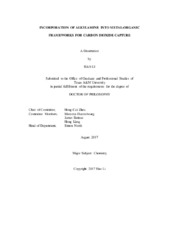| dc.description.abstract | The escalating atmospheric CO₂ concentration is one of the most urgent environmental concerns of our age. To effectively capture CO₂, various materials have been studied, such as aqueous alkanolamine solutions, zeolites, activated carbons. However, none of these materials fulfill all the crucial performance parameters for CO₂ capture materials, including but not limited to, high CO₂ selectivity, reasonable regeneration cost, and stability under the operational conditions. Metal-organic frameworks (MOFs) are an emerging class of porous materials constructed from metal-containing nodes and organic linkers. Owing to their high porosity, high surface area, and tunable functionality, MOFs have been investigated extensively to date as promising candidates to be applied in real-world CO₂ capture scenarios. Among them, alkylamine-modified MOFs exhibit significantly improved CO₂ selectivity because of the chemical interaction between the surface functionalities of MOFs and CO₂ molecules.
In most cases, alkylamine molecules are integrated into MOFs via the coordination bonds formed between open metal sites (OMSs) and amine groups. Thus, the alkylamine density as well as the corresponding CO₂ uptake in MOFs are severely restricted by the density of OMSs. To overcome this limit, other approaches to incorporating alkylamine into MOFs are highly desired. Therefore, a new method based on the Brønsted acid-base reaction between MOFs and alkylamine was explored for alkylamine grafting. The pristine MOF utilized is Cr-MIL-101-SO₃H (MIL = Materials of Institute Lavoisier), which has a high density of inherent sulfonic acid groups to interact with amine groups. A systematic optimization of the experimental conditions involved in alkylamine tethering was conducted to maximize the CO₂ uptakes of the obtained modified MOFs. The study reveals that experimental factors, such as alkylamine structure and solvent species, play an important role in determining the alkylamine loading amount in MOFs and their accompanying CO₂ capacities. This conclusion was further applied in the case of Cr-MIL-101. With judiciously selected alkylamine and solvent species, the CO₂ uptake of the alkylamine-functionalized Cr-MIL-101 was dramatically enhanced compared with the previously reported results. The improvement was rationalized from a thermodynamic perspective. | en |


